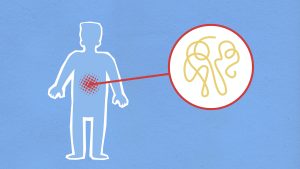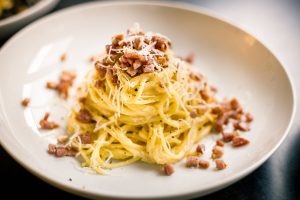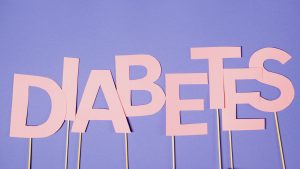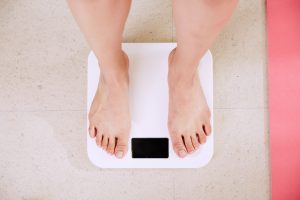Can I Manage My Chronic Inflammation?
 Inflammation is a necessary function of the body to protect it from invading bacteria and harmful substances. However, when inflammation becomes chronic, it can actually cause damage to the body and lead to health issues, which can include cardiovascular problems. You can manage chronic inflammation by making some healthy lifestyle changes, such as switching your diet, getting adequate sleep and hydration and exercising regularly.
Inflammation is a necessary function of the body to protect it from invading bacteria and harmful substances. However, when inflammation becomes chronic, it can actually cause damage to the body and lead to health issues, which can include cardiovascular problems. You can manage chronic inflammation by making some healthy lifestyle changes, such as switching your diet, getting adequate sleep and hydration and exercising regularly.
Eat more greens and colorful veggies and fruits.
You probably know by now that food like kale and other leafy greens, such as oak leaf lettuce are exceptionally good for your health and can help reduce inflammation. Other colorful fruits also help. The group of blue, red and orange fruits and veggies, such as cherries, blueberries and strawberries, also help reduce inflammation. Cutting out food high in added sugar or those highly processed makes a huge difference too. By simply cutting out food with added sugar and eating fresh fruit instead, you can reduce inflammation significantly.
Eat fish, but not deep-fried fish.
Fried foods add to inflammation, just as fats like margarine do. Cut back on meat and eat fatty baked fish instead. While red meat doesn’t increase inflammation, it doesn’t help reduce it either. Use red meat substitutes, such as fish or beans as main fare a few days a week to significantly reduce inflammation. It’s especially good for the heart. Fatty fish contains omega3 fatty acids, which are natural anti-inflammatories. When choosing oil, don’t use corn oil, soybean oil and hydrogenated oils, instead, choose olive oil, avocado oil or flaxseed oil.
Other factors that affect chronic inflammation can increase the risk of some serious conditions.
Chronic inflammation is associated with severe diseases like rheumatoid arthritis, IBS, Crohn’s, bone damage and gum disease. It’s also associated with premature aging of the skin, diseases of the blood vessels, COPD and cancer. While diet and exercise can help, other factors play a role. An imbalance in blood sugar levels, lack of sleep, stress, environmental factors and chronic infection also play a role. A program of regular exercise produces IL-6, which reduces TNF that starts the process of inflammation.
- Certain herbs can help reduce inflammation. These anti-inflammatory herbs include hot chili pepper, ginger root, lemongrass, rosemary, aloe and turmeric. In fact, turmeric is thought to help improve neural stem cell regeneration in the brain.
- You can aid your digestion and reduce inflammation at the same time when you eat pineapple. Eat it with ginger tea and you’ll get double the benefit. Pineapple is also good for reducing the inflammation of arthritis.
- What you drink makes a big difference. Not only does sugar cause inflammation, but drinks with artificial sweeteners do also too! Opt for green tea, plain coffee, water or ginger tea instead.
- Reduce stress and get more sleep to help eliminate chronic inflammation. Stress reduction can come from exercise, meditation, or breathing exercises. Making your home environmentally friendly also helps.
For more information, contact us today at Rising Fitness Gym



 Even if you don’t like regular winter squash, you’ll probably like spaghetti squash. It’s a type of winter squash that when cooked, can be separated from the outer shell in strings that resemble spaghetti, but is low in calories and loaded with nutrition. Another big benefit of spaghetti squash is its high fiber content. It has far more than traditional pasta, similar to most vegetables. Fiber is good for colon health and fills you up so you don’t eat as much, making it also good for weight loss.
Even if you don’t like regular winter squash, you’ll probably like spaghetti squash. It’s a type of winter squash that when cooked, can be separated from the outer shell in strings that resemble spaghetti, but is low in calories and loaded with nutrition. Another big benefit of spaghetti squash is its high fiber content. It has far more than traditional pasta, similar to most vegetables. Fiber is good for colon health and fills you up so you don’t eat as much, making it also good for weight loss.
 During the summer, Houston, Texas, can get sizzling hot. That can bring on a series of heat related conditions. Two of the most common conditions are heat stroke and heat exhaustion. Heat exhaustion occurs when sweating too much causes dehydration and electrolyte imbalance. Heat stroke occurs when the body can no longer control its internal temperature. Heat exhaustion can become heat stroke and heat stroke is the most dangerous of the two. It helps to know the symptoms of heat stroke for both your health and the health of those around you. This serious condition needs immediate attention.
During the summer, Houston, Texas, can get sizzling hot. That can bring on a series of heat related conditions. Two of the most common conditions are heat stroke and heat exhaustion. Heat exhaustion occurs when sweating too much causes dehydration and electrolyte imbalance. Heat stroke occurs when the body can no longer control its internal temperature. Heat exhaustion can become heat stroke and heat stroke is the most dangerous of the two. It helps to know the symptoms of heat stroke for both your health and the health of those around you. This serious condition needs immediate attention.
 There’s a lot of variation on how long you need to workout every day to stay fit. Some say it’s an hour, while other focus on 30 minutes-a-day. Most research varies because everyone is different with different goals and there are different levels of intensity during exercise. If your goal is to become a better athlete, you’ll need to push yourself harder to get fit and stay fit for your sport. If you’ve been a couch potato, a half hour will definitely help you get into shape.
There’s a lot of variation on how long you need to workout every day to stay fit. Some say it’s an hour, while other focus on 30 minutes-a-day. Most research varies because everyone is different with different goals and there are different levels of intensity during exercise. If your goal is to become a better athlete, you’ll need to push yourself harder to get fit and stay fit for your sport. If you’ve been a couch potato, a half hour will definitely help you get into shape.
 A complete approach to fitness is important. Considering nutrition as part of your fitness plan can help improve your health and help you achieve your goals quickly. At Rising Fitness in Houston, TX, we encourage both a healthy diet and regular exercise. Part of your healthy diet can include using a protein supplement, particularly after an intense workout. To get the maximum nutrition from your protein supplement, make your own home protein shake. You can include a number of ingredients and make it a drink you’ll love that’s also healthy.
A complete approach to fitness is important. Considering nutrition as part of your fitness plan can help improve your health and help you achieve your goals quickly. At Rising Fitness in Houston, TX, we encourage both a healthy diet and regular exercise. Part of your healthy diet can include using a protein supplement, particularly after an intense workout. To get the maximum nutrition from your protein supplement, make your own home protein shake. You can include a number of ingredients and make it a drink you’ll love that’s also healthy.
 When you want to lose weight, both diet and exercise are important. Which is the most important? It’s actually your diet. You simply can’t out-exercise a bad diet. However, exercise boosts your weight loss efforts, so it can make it easier. It not only burns extra calories, but it also builds muscle tissue, which requires more calories than fat tissue does. That effectively boosts your metabolism. Even if you have no time to exercise there are some things you can do to boost your activity level, which is important.
When you want to lose weight, both diet and exercise are important. Which is the most important? It’s actually your diet. You simply can’t out-exercise a bad diet. However, exercise boosts your weight loss efforts, so it can make it easier. It not only burns extra calories, but it also builds muscle tissue, which requires more calories than fat tissue does. That effectively boosts your metabolism. Even if you have no time to exercise there are some things you can do to boost your activity level, which is important.
 If you’re carrying extra weight, it’s like walking around with barbells or dumbbells attached to your body. It’s not so bad if it’s just a few pounds, but more than if you’re more than five percent overweight, it can start to affect your health. Obesity and excess weight can cause hormonal changes that even affect your metabolism, making it even harder to lose weight. One area that is often noticed by individuals is joint pain. You can imagine how damaging the excess weight is to your knees, hips and ankles every time you take a step.
If you’re carrying extra weight, it’s like walking around with barbells or dumbbells attached to your body. It’s not so bad if it’s just a few pounds, but more than if you’re more than five percent overweight, it can start to affect your health. Obesity and excess weight can cause hormonal changes that even affect your metabolism, making it even harder to lose weight. One area that is often noticed by individuals is joint pain. You can imagine how damaging the excess weight is to your knees, hips and ankles every time you take a step.
 Setting a goal for activity is motivating. That’s why 10,000 daily steps became so popular. There’s no better place than Houston, Texas, if you want to walk. Sometimes weather, a busy schedule or other interruptions can deter you from your goal. Here are a few ways to increase your daily steps and some less obvious ways to get your 10,000 steps for the day.
Setting a goal for activity is motivating. That’s why 10,000 daily steps became so popular. There’s no better place than Houston, Texas, if you want to walk. Sometimes weather, a busy schedule or other interruptions can deter you from your goal. Here are a few ways to increase your daily steps and some less obvious ways to get your 10,000 steps for the day.
 When you read articles stating how many calories you need based on height, weight and sex, they’re generalized. No two people are alike. Your body build makes a difference, so does your activity level. In general, however, men need more calories than women do. It can be pretty discouraging if you’re a woman who has started a weight loss program with her husband to watch him lose weight faster, sometimes even eating more. There are differences in the body bodies of men and women that can cause that to occur.
When you read articles stating how many calories you need based on height, weight and sex, they’re generalized. No two people are alike. Your body build makes a difference, so does your activity level. In general, however, men need more calories than women do. It can be pretty discouraging if you’re a woman who has started a weight loss program with her husband to watch him lose weight faster, sometimes even eating more. There are differences in the body bodies of men and women that can cause that to occur.
 There are ways to lose ten pounds a week, but in most cases, they involve illness and water weight loss. You can lose more than 1-2 pounds a week and still be healthy, but the rate won’t necessarily continue throughout your weight loss efforts. There are healthy ways to lose weight and unhealthy ones. The unhealthy ones include fad starvation diets. The problem with a fad diet is that you often lose a lot of water weight, making the weight loss anything but permanent.
There are ways to lose ten pounds a week, but in most cases, they involve illness and water weight loss. You can lose more than 1-2 pounds a week and still be healthy, but the rate won’t necessarily continue throughout your weight loss efforts. There are healthy ways to lose weight and unhealthy ones. The unhealthy ones include fad starvation diets. The problem with a fad diet is that you often lose a lot of water weight, making the weight loss anything but permanent.